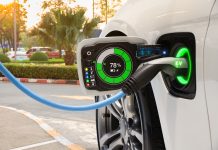Olivia Serrage, Group Marketing Manager at evec, looks to the future of transport, explaining why sustainability will be better achieved with the adoption of electric vehicles
As advocates for sustainable transport, we firmly believe that electric vehicles (EVs) are the future of transport, and the way forward in the fight against climate change and air pollution.
Despite the growing popularity of EVs, there are still prevalent myths that hinder their widespread adoption. Our mission is to dispel these myths and misconceptions through evidence-based facts.
Myth: Electric vehicles have limited charging infrastructure available
In the United Kingdom, the government has taken significant steps to improve the charging infrastructure to make EV charging more accessible across the country. As outlined in a report by Edie (2023), the UK government has set out a comprehensive plan to make smart EV charging the norm.
Last year, there were 8,700 public EV chargers installed, with plans to install a further 127,000 by 2025. Furthermore, the plan also emphasises the use of smart technologies to optimise the charging process, enabling better management of energy demand and grid integration in the future of transport.
The UK’s commitment to expanding the charging infrastructure is evident through various initiatives and partnerships. For instance, the government’s Electric Vehicle Homecharge Scheme provides grants to support the installation of domestic EV charging points, making it easier for individuals to charge their EVs at home.
Additionally, collaborations with private companies and organisations have resulted in the establishment of extensive charging networks, including fast-charging stations at popular public locations such as shopping centres, service stations and car parks.
Myth: Electric vehicles strain the electrical grid
Fact: The transition to EVs can be effectively managed by the electrical grid. As the adoption of EVs increases, so does the deployment of renewable energy sources and grid optimisation technologies. In fact, according to the International Energy Agency (2021), the electricity demand from EVs can be met without significant infrastructure upgrades in most countries.
National Grid, the UK’s electricity system operator, is actively involved in the transition to a greener future. They are implementing various measures to ensure the grid can handle the rising demand for electricity from EVs and accommodate for new innovation for the future of transport.
As more EVs are charged, there is a greater need for clean energy to power them. National Grid is working towards increasing the share of renewable energy in the overall electricity generation mix. By expanding the capacity of wind, solar, and other renewable sources, they can meet the growing demand for electricity without relying heavily on fossil fuel-based power plants.
The road ahead: Embracing the electric revolution
The myths surrounding EVs are being debunked, revealing the future of transport where EVs play a crucial role in combating climate change and creating a sustainable transport system.
With their environmental benefits, supported by research showing reduced greenhouse gas emissions, even when accounting for electricity generation, EVs have emerged as a viable and sustainable transport option.
The positive trajectory of EVs, coupled with the National Grid’s preparedness for increased demand, presents a significant opportunity to embrace the electric revolution and build a greener and more efficient future for generations to come.
















This is nonsense. Electric vehicles are not green, take twice as much carbon during manufacture, twice the price of a normal car, government assistance to help buy now zero, tax to be per mile,. plus extra tax on ev tyres. what of battery disposal after life? not green. no government infrascructure for charges, all left to ‘private’ companies who charge way over the top for electricity, plus now insurance companies are telling electric installers to place chargers at commercial points at least 7.5 metres away from buildings because of high fire risk. lithium batteries huge fire risk as has been proved by charges in homes for electric bikes/scooters